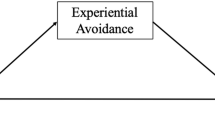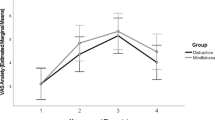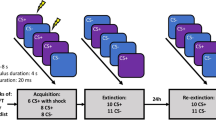Abstract
Previous research has shown that those with anxiety disorders may avoid distressing emotions, which in turn may increase avoidance behavior and help to maintain anxiety symptoms. The current study used an analogue laboratory design to investigate whether engaging in a brief mindfulness induction may result in decreased avoidance behavior following a fear-inducing stimulus. Undergraduate students were randomly assigned to listen to a brief mindfulness induction or to a control audio designed to induce unfocused attention. They were then shown a fear-inducing or neutral film clip. Avoidance behavior was measured by the likelihood of quitting a frustrating math task. Of those participants watching the fear-inducing film clip, those in the mindfulness group were less likely to quit the frustrating task than those in the control audio group. There was no difference in persistence between the mindfulness and control groups after the neutral film. Perhaps mindfulness training can boost persistence after the experience of fear.

Similar content being viewed by others
References
Arch, J. J., & Craske, M. G. (2006). Mechanisms of mindfulness: emotion regulation following a focused breathing induction. Behaviour Research and Therapy, 44, 1849–1858.
Baer, R. (2003). Mindfulness training as a clinical intervention: a conceptual and empirical review. Clinical Psychology: Science and Practice, 10, 125–143.
Batten, S. V., Orsillo, S. M., & Walser, R. D. (2005). Acceptance and mindfulness-based approaches to the treatment of post-traumatic stress disorder. In S. M. Orsillo & L. Roemer (Eds.), Acceptance and mindfulness-based approaches to anxiety: conceptualization and treatment (pp. 241–260). New York: Springer.
Cahill, S. P., & Foa, E. B. (2007). Psychological theories of PTSD. In M. J. Friedman, T. M. Keane, & P. A. Resick (Eds.), Handbook of PTSD: science and practice (pp. 55–77). New York: Guilford Press.
Cropley, M., Ussher, M., & Charitou, E. (2007). Acute effects of a guided relaxation routine (body scan) on tobacco withdrawal symptoms and cravings in abstinent smokers. Addiction, 102, 989–993.
Daughters, S. B., Lejuez, C. W., Bornovalova, M. A., Kahler, C. W., Strong, D. R., & Brown, R. A. (2005). Distress tolerance as a predictor of early treatment dropout in a residential substance abuse treatment facility. Journal of Abnormal Psychology, 114, 729–734.
Eifert, G. H., Forsyth, J. P., Arch, J., Espejo, E., Keller, M., & Langer, D. (2009). Acceptance and commitment therapy for anxiety disorders: three case studies exemplifying a unified treatment protocol. Cognitive Behavioral Practice, 16, 368–385.
Erisman, S. M., & Roemer, L. (2010). A preliminary investigation of the effects of experimentally induced mindfulness on emotional responding to film clips. Emotion, 10, 72–82.
Erisman, S. M., & Roemer, L. (2012). A preliminary investigation of the process of mindfulness. Mindfulness, 3, 30–43.
Evans, D. R., Baer, R. A., & Segerstrom, S. C. (2009). The effects of mindfulness and self-consciousness on persistence. Personality and Individual Differences, 47, 379–382.
Follette, V., Palm, K. M., & Pearson, A. N. (2006). Mindfulness and trauma: implications for treatment. Journal of Rational-Emotive & Cognitive-Behavior Therapy, 24, 45–61.
Gross, J. J., & Thompson, R. A. (2007). Emotion regulation: conceptual foundations. In J. J. Gross (Ed.), Handbook of emotion regulation. New York: Guilford.
Hayes, S. C., Wilson, K. G., Gifford, E. V., Follette, V. M., & Strosahl, K. (1996). Experiential avoidance and behavioral disorders: a functional dimensional approach to diagnosis and treatment. Journal of Consulting and Clinical Psychology, 64, 1152–1168.
Hofmann, S. G., Sawyer, A. T., Witt, A. A., & Oh, D. (2010). The effect of mindfulness-based therapy on anxiety and depression: a meta-analytic review. Journal of Consulting and Clinical Psychology, 78, 169–183.
Jha, A. P., Stanley, E. A., Kiyonaga, A., Wong, L., & Gelfand, L. (2010). Examining the protective effects of mindfulness training on working memory capacity and affective experience. Emotion, 10, 54–64.
Kabat-Zinn, J. (1990). Full catastrophe living: using the wisdom of your body and mind to face stress, pain, and illness. New York: Dell Publishing.
Kiken, L. G., & Shook, N. J. (2011). Looking up: mindfulness increases positive judgments and reduces negativity bias. Social Psychological and Personality Science, 2, 425–431.
McHugh, L., Simpson, A., & Reed, P. (2010). Mindfulness as a potential intervention for stimulus over-selectivity in older adults. Research in Developmental Disabilities, 31, 178–184.
Roemer, L., Salters, K., Raffa, S. D., & Orsillo, S. M. (2005). Fear and avoidance of internal experiences in GAD: preliminary tests of a conceptual model. Cognitive Therapy and Research, 29, 71–88.
Rottenberg, J., Ray, R. D., & Gross, J. J. (2007). Emotion elicitation using films. In J. A. Coan & J. B. Allen (Eds.), Handbook of emotion elicitation and assessment (pp. 9–28). New York: Oxford University Press.
Sauer, S., Walach, H., Schmidt, S., Hinterberger, T., Lynch, S., Bussing, A., Kohls, N. (2012). Assessment of mindfulness: review on state of the art. Mindfulness. Advance online publication. Retrieved August 6, 2012. doi: 10.1007/s12671-012-0122-5.
Segal, Z. V., Williams, J. M. G., & Teasdale, J. D. (2002). Mindfulness-based cognitive therapy for depression: a new approach to preventing relapse. New York: Guilford Press.
Smith, C. A., & Kirby, L. D. (2009). Relational antecedents of appraised problem focused coping potential and its associated emotions. Cognition and Emotion, 23, 481–503.
Thompson, B. L., & Waltz, J. (2010). Mindfulness and experiential avoidance as predictors of posttraumatic stress disorder avoidance symptom severity. Journal of Anxiety Disorders, 24, 409–415.
Acknowledgments
This paper was conducted as part of a master's thesis by Elisabeth Carlin under the direction of Anthony Ahrens. We thank Joanna Arch, Michelle Craske, Leslie Kirby, and Craig Smith for sharing instructions and stimuli used in this study. We thank Sonya Bendriem, Darcy Brown, and Jeannine Brown for their assistance with various aspects of the project, and Michele Carter and Kristalyn Salters-Pedneault for their feedback on the thesis on which this is based.
Author information
Authors and Affiliations
Corresponding author
Rights and permissions
About this article
Cite this article
Carlin, E.A., Ahrens, A.H. The Effects of Mindfulness and Fear-Inducing Stimuli on Avoidance Behavior. Mindfulness 5, 276–281 (2014). https://doi.org/10.1007/s12671-012-0177-3
Published:
Issue Date:
DOI: https://doi.org/10.1007/s12671-012-0177-3




